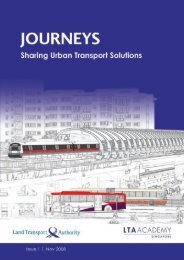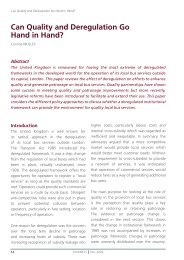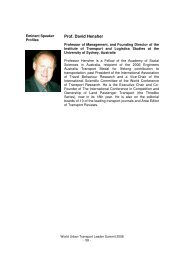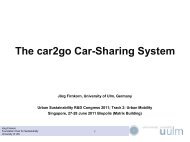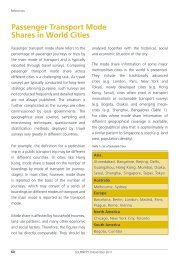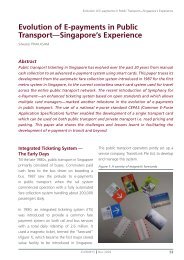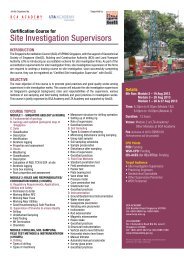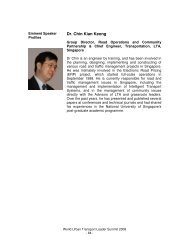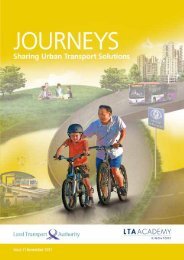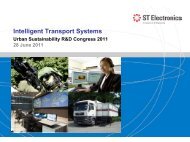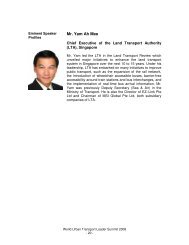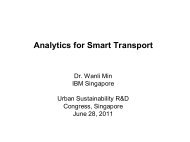Issue 4 May 2010 - LTA Academy
Issue 4 May 2010 - LTA Academy
Issue 4 May 2010 - LTA Academy
You also want an ePaper? Increase the reach of your titles
YUMPU automatically turns print PDFs into web optimized ePapers that Google loves.
Household Interview Surveys from 1997 to 2008 – A Decade of Changing Travel Behaviours<br />
expanding the RTS is the right strategy<br />
going forward to attract more people to use<br />
public transport.<br />
In the LTMP, the Government announced that<br />
it will commit over $20 billion to double the<br />
existing 138 km of rail network to 278 km.<br />
This will increase the RTS density from 31 km<br />
per million population today to 51 km per<br />
million population, comparable to cities like<br />
New York and London, and surpasses RTS<br />
densities in Hong Kong and Tokyo today.<br />
Within the city centre, commuters will be able<br />
to access an RTS station within a 400 metre<br />
radius, or a five-minute walk. As seen earlier in<br />
Figure 6, this improvement in the accessibility<br />
to the MRT will have positive impact on the<br />
mode share and create better utilisation of the<br />
PT facilities.<br />
To complement the RTS network, <strong>LTA</strong> will also<br />
spend resources to improve the bus system for<br />
better integration between the PT modes and<br />
ensure the success of Singapore’s ‘hub-and-<br />
60<br />
<strong>LTA</strong> will also spend resources to<br />
improve the bus system for better<br />
integration between the PT modes<br />
and ensure the success of Singapore’s<br />
‘hub-and-spoke’ public transport<br />
network.<br />
Notes<br />
1. There is a longer gap between 1997 and 2004<br />
surveys because the HITS was conducted only after<br />
Northeast Line (NEL) was opened in 2003.<br />
2. The sampling rate is kept constant so to be<br />
comparable across surveys. It is also consistent with<br />
the recommended home interview sampling rate<br />
JOURNEYS <strong>May</strong> <strong>2010</strong><br />
spoke’ public transport network. Initiatives,<br />
such as, building integrated transport hubs<br />
and creating integrated fare structures, will<br />
enhance seamless bus-rail transfers. In addition,<br />
more bus priority schemes and premium bus<br />
services will greatly enhance the experience<br />
of bus passengers, thus improving the overall<br />
attractiveness of the PT system. In a nutshell,<br />
<strong>LTA</strong> is adopting a holistic approach to make<br />
the PT a choice mode for Singapore residents.<br />
Conclusion<br />
A decade of HITS has provided Singapore<br />
transport professionals with vital feedback<br />
about the travel behaviours of Singapore<br />
residents. The results have helped in making<br />
decisions about the types of transport<br />
infrastructure to be provided and the policies<br />
needed to make Singapore a liveable city.<br />
However, the observations on behaviour<br />
also presented many challenges in building a<br />
sustainable transport system. The solutions to<br />
some of the challenging transport issues have<br />
been provided in the Land Transport Master<br />
Plan. By adopting both pull and push measures,<br />
such as the expansion of the MRT network,<br />
reducing the car population and refining the<br />
ERP system, <strong>LTA</strong> aims to address the falling PT<br />
mode share and create a sustainable transport<br />
system for future generations of Singaporeans.<br />
of 1.5% to 0.5% for a population above 1 million.<br />
For HITS 2008, about 10,500 households were<br />
interviewed.<br />
3. Passenger servicing trips refer to trips made by<br />
motorists in picking-up or dropping-off passengers<br />
who are on their first/last mile. These motorists will



